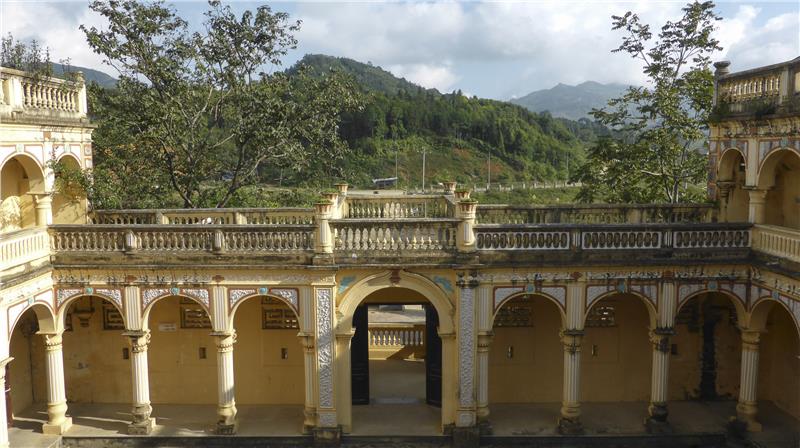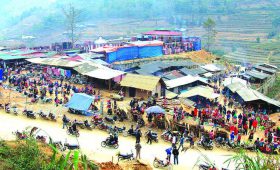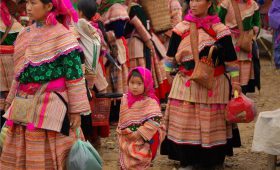Hoang A Tuong Castle is designed in the harmonious combination of Asian – European architectural style. Undergoing more than 80 years of existence, the building still majestically stand among a populated town and bustling streets. As one of the potential attractions in Sapa, Hoang A Tuong Castle is now located on high and dry land in the center of Bac Ha district, Lao Cai province. Before 1945, Bac Ha was ruled under semi-feudal colonial regime with the ruling class and the ruled one. The ruling class is the tribal mandarin which is typical of father and son Hoang Yen Chao – Hoang A Tuong. To assert his power and wealth, Hoang Yen Chao has talented architects design and build a palatial mansion with unique architecture. Hoang A Tuong Castle was built in 1914 and completed in 1921. The French and Chinese architects designed and directly controlled the castle. Ideal position selected according to feng shui theory is perched on a large hill to the southeast. Behind and both sides of the castle are mountain; meanwhile, facade is a stream and massive mountain. The terrain generally is relatively harmonious which is suitable for the landscapes and climate of this land.
Hoang A Tuong Castle owned a fairly particular architectural structure compared to the architecture of other edifices in Vietnam at that time. The castle played a role as a place to stay of Hoang Yen Chao and Hoang A Tuong; simultaneously, it was the workplace and took its functions as the fort to protect his family. The entire castle retained closed continuous rectangular architecture with a total area of 4.000m2. The architecture of the castle maintained the blend between French architecture in 17-18 century and Oriental architecture. Western side of the building is expressed in detail such as laurels motifs embossed on entrance gates symbolizing for happiness and prosperity, arched railing doors, the elegant pillars, round balustrades and staircases, and tiled hallway.
Hoang A Tuong had deliberately prepared materials for building the castle. Cement and steel were flown from the plains, while the bricks and tiles were manufactured on the spot with clay in the heart of the mountain range under the supervision of Chinese experts. The whole edifice was built of baked bricks and employed a binding agent with lime and beeswax. Workers were the best builders from prisons. Surrounding Hoang A Tuong Castle was the thick fence consisting of 3 gates (1 main gate and 2 auxiliary ones). Four side walls were crenellated fences and guarded by 2 platoons. In particular, behind the castle offered a solid and extremely secretive escaping tunnel.
Internal structure of the castle is fairly beautiful. Through the main entrance, a large yard inside is former home to organize main activities of the tribal mandarin’s family. Backcourt main building retains two floors with an area of 420m2, which is often used for the meeting place of the family. Tourists setting foot in the castle have to walk up 17 stairs from both sides, then to the sheltered lounge. Additionally, the castle also has other construction items such as two auxiliary blocks on both sides. Each has two floors and is lower than the main building with an area of 300m2. This is private space of Hoang Yen Chao’s wives and Hoang A Tuong’s wives. There are also two sub-blocks with simpler architecture used as accommodation for soldiers and servants.
Hoang A Tuong Castle is an architectural works harmoniously mingled between ancient French house architecture and Oriental architectural style. The prominent Western architecture creates particular beauty for whole building. It has become the indispensable tourist address for tourists when visiting the white highlands of Bac Ha. The castle has stored, preserved and embellished so far. Thanks to this achievement, tourists have more chance to ascertain about the history and society of a bygone era ethnic minority. Tourists participating in Sapa travel should set foot in Hoang A Tuong Castle to experience the majestic beauty of the ancient mansion.



